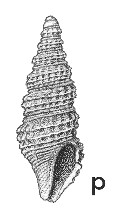
Revised descriptions of New Zealand Cenozoic Mollusca from Beu and Maxwell (1990)

 | Revised descriptions of New Zealand Cenozoic Mollusca from Beu and Maxwell (1990) | 
|
  (Pl. 49p): GS10297, O32/f8110A, Leader River, "Mendip Hills" Station, near Parnassus, North Canterbury, Castlecliffian (GNS) |
Beu & Maxwell (1990): Chapter 16; p. 367; pl. 49 p.
Synonymy: Pleurotoma wanganuiensis Hutton 1873b, p. 4; Drillia wanganuiensis. Beu (2009) discussed the synonymy and variation, and provided a long list of synonyms.
Type species of Aoteadrillia Powell, 1942
Classification: Conidae: Clathurellinae(?) (not analysed by Puillandre et al. 2008)
Description: Small for family (10-12.5 mm high), tall and narrow, with moderately tall spire (2.2 times height of aperture and canal) but very short, widely open anterior canal with oblique, notched anterior end but no obvious fasciole. Sculpture of narrow, well raised, widely spaced spiral cords, 3-4 on spire whorls and on upper part of last whorl of most specimens, but variable in number and prominence; base with many low, closely spaced cords; crossing many low, narrow axial costae with only very weak nodules at intersections. Anal sinus deep, U-shaped, occupying shallowly concave sutural ramp, margined above by a heavy subsutural cord. Aperture simple, lips thin, without parietal callus. Protoconch relatively large, low, dome-shaped, of 2.5 whorls, initially smooth but with blunt median cord on last whorl, and many fine spiral threads on apex.
Comparison: The closely related living form named Aoteadrillia chordata (Suter) has larger nodules at the sculptural intersections than on most Castlecliff specimens of A. wanganuiensis, but sculpture is variable in all Aoteadrillia populations, and A. chordata was synonymised with A. wanganuiensis by Beu (2009). The restricted Nukumaruan species A. finlayi is considerably larger, more finely sculptured, and has a taller and more prominently keeled protoconch than A. wanganuiensis (= "Paracomitas n. sp." of Marwick 1965, pl. 11, fig. 18). A. wanganuiensis intergrades with many named forms from Nukmaruan rocks in Hawke's Bay and South Wairarapa, some of which have finer spiral sculpture than typical Castlecliff shells of A. wanganuiensis, but most of which are coarsely axially ribbed forms, some not unlike the Recent chordata form. This variation evidently was a response to the cold waters of early Nukumaruan time, when the Zygochlamys delicatula fauna migrated northwards to appear in Wairarapa and Wanganui. Beu (2009) discussed these variants and synonymised them with A. wanganuiensis. A. wanganuiensis appears to have evolved quite gradually from a lineage of small species with finer spiral cords, such as A. waihuaensis (Waipipian-Mangapanian?).
Distribution: Nukumaruan-Recent; Shakespeare Cliff, Wanganui (Tainui Shellbed ?), Castlecliffian (type); moderately common in most Castlecliffian siltstone beds at Wanganui, in Nukumaruan siltstone in Wairarapa and Hawke's Bay, and in Nukumaruan to Castlecliffian siltstone in North Canterbury.
Cite this publication as: "A.G. Beu and J.I. Raine (2009). Revised
descriptions of New Zealand Cenozoic Mollusca from Beu and Maxwell (1990). GNS
Science miscellaneous series no. 27."
© GNS Science, 2009
ISBN
978-0-478-19705-1
ISSN 1177-2441
(Included with a PDF facsimile file
copy of New Zealand Geological Survey Paleontological Bulletin 58 in CD version
from: Publications Officer, GNS Science, P.O. Box 30368 Lower Hutt, New
Zealand)